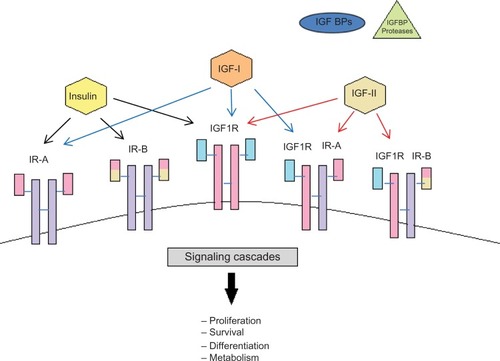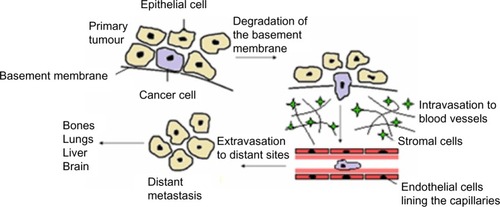Figures & data
Figure 1 Schematic representation of the insulin-like growth factor system.
Notes: The IGF system consists of peptides (IGF-I, IGF-II and insulin), receptors (the IGF-I receptor, the IR, and the IGF-II), a family of six high-affinity IGFBPs, as well as a group of proteases that are responsible for IGFBP degradation. Ligand binding to the receptor results in activation of different intracellular signaling pathways that regulate cell survival, proliferation differentiation, and metabolism.
Abbreviations: IGF, insulin-like growth factor; IGFBP, insulin-like growth factor–binding protein; IR, insulin receptor.
Abbreviations: IGF, insulin-like growth factor; IGFBP, insulin-like growth factor–binding protein; IR, insulin receptor.

Figure 2 Schematic outline of breast cancer progression.
Notes: To begin the process of metastasis a malignant cell must migrate away from the primary tumor; this requires the degradation of the basement membrane. Following entry to the stroma, a cancer cell must invade the circulatory system via intravasation into existing or newly formed blood or lymph vessels. The cells need to survive the transport through the vasculature and then extravasate from the circulation to establish secondary tumors in distant sites; bone, lungs, liver, and brain are the most common sites for metastasis of breast cancer.

Figure 3 Epithelial-to-mesenchymal transitions.
Notes: The epithelial cells are closely packed, highly polarized cells that are not particularly motile. During EMT, signals provided by the stromal cells cause epithelial cells to lose their cell characteristics and acquire a mesenchymal cell phenotype characterized by enhanced migratory capacity and invasiveness and high expression of mesenchymal markers.
Abbreviations: EMT, epithelial-to-mesenchymal transition; MET, mesenchymal-to-epithelial transition.
Abbreviations: EMT, epithelial-to-mesenchymal transition; MET, mesenchymal-to-epithelial transition.

